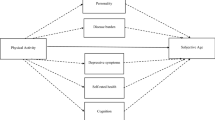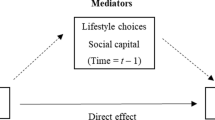Abstract
Background
When examining older adults’ health behaviors and psychological health, it is important to consider the social context.
Purpose
The purpose of this study was to examine in older adult marriages whether each spouse’s physical activity predicted changes in their own (actor effects) and their partner’s (partner effects) depressive symptoms. Gender differences were also examined.
Method
Each spouse within 1260 married couples (at baseline) in the Cardiovascular Health Study completed self-report measures at wave 1 (1989–1990), wave 3 (1992–1993), and wave 7 (1996–1997). Dyadic path analyses were performed.
Results
Husbands’ physical activity significantly predicted own decreased depressive symptoms (actor effect). For both spouses, own physical activity did not significantly predict the spouse’s depressive symptoms (partner effects). However, husbands’ physical activity and depressive symptoms predicted wives’ physical activity and depressive symptoms (partner effects), respectively. Depressive symptoms did not predict physical activity.
Conclusion
Findings suggest that husbands’ physical activity is particularly influential for older married couples’ psychological health.

Similar content being viewed by others
References
Loprinzi PD. Objectively measured light and moderate-to-vigorous physical activity is associated with lower depression levels among older US adults. Aging Ment Health. 2013; 17(7): 801-805.
Teychenne M, Ball K, Salmon J. Physical activity and likelihood of depression in adults: A review. Prev Med. 2008; 46(5): 397-411.
Kerse N, Hayman KJ, Moyes SA, et al. Home-based activity program for older people with depressive symptoms: DeLLITE–a randomized controlled trial. Ann Fam Med. 2010; 8(3): 214-223.
Blumenthal JA, Babyak MA, Moore KA, et al. Effects of exercise training on older patients with major depression. Arch Intern Med. 1999; 159(19): 2349-2356.
Phillips WT, Kiernan M, King AC. Physical activity as a nonpharmacological treatment for depression: A review. Complement Health Pract Rev. 2003; 8(2): 139-152.
Roberts RE, Kaplan GA, Shema SJ, Strawbridge WJ. Does growing old increase the risk for depression? Am J Psychiatr. 1997; 154(10): 1384-1390.
Stewart AL, Hays RD, Wells KB, Rogers WH, Spritzer KL, Greenfield S. Long-term functioning and well-being outcomes associated with physical activity and exercise in patients with chronic conditions in the medical outcomes study. J Clin Epidemiol. 1994; 47(7): 719-730.
Meyler D, Stimpson JP, Peek MK. Health concordance within couples: A systematic review. Soc Sci Med. 2007; 64(11): 2297-2310.
Li K-K, Cardinal BJ, Acock AC. Concordance of physical activity trajectories among middle-aged and older married couples: Impact of diseases and functional difficulties. J Gerontol B Psychol Sci Soc Sci. 2013; 68(5): 794-806.
Ayotte BJ, Yang FM, Jones RN. Physical health and depression: A dyadic study of chronic health conditions and depressive symptomatology in older adult couples. J Gerontol B Psychol Sci Soc Sci. 2010; 65(4): 438-448.
Hoppmann C, Gerstorf D. Spousal interrelations in old age–a mini-review. Gerontology. 2009; 55(4): 449-459.
Hoppmann CA, Gerstorf D, Hibbert A. Spousal associations between functional limitation and depressive symptom trajectories: Longitudinal findings from the study of Asset and Health Dynamics Among the Oldest Old (AHEAD). Health Psychol. 2011; 30(2): 153.
Ryan LH, Wan WH, Smith J. Spousal social support and strain: Impacts on health in older couples. J Behav Med. 2014; 37: 1108-1117.
Samios C, Pakenham KI, O’Brien J. A Dyadic and longitudinal investigation of adjustment in couples coping with multiple sclerosis. Ann Behav Med. 2014; 49: 74-83.
Cesari M, Vellas B, Hsu F-C, et al. A physical activity intervention to treat the frailty syndrome in older persons—results from the LIFE-P study. J Gerontol A Biol Sci Med Sci. 2014; 70(2): 216-222.
Martire LM, Schulz R, Helgeson VS, Small BJ, Saghafi EM. Review and meta-analysis of couple-oriented interventions for chronic illness. Ann Behav Med. 2010; 40(3): 325-342.
Conn V, Valentine J, Cooper H. Interventions to increase physical activity among aging adults: A meta-analysis. Ann Behav Med. 2002; 24(3): 190-200.
Pettee KK, Brach JS, Kriska AM, et al. Influence of marital status on physical activity levels among older adults. Med Sci Sports Exerc. 2006; 38(3): 541-546.
Townsend AL, Miller B, Guo S. Depressive symptomatology in middle-aged and older married couples a dyadic analysis. J Gerontol Ser B Psychol Sci Soc Sci. 2001; 56(6): S352-S364.
Umberson D. Gender, marital status and the social control of health behavior. Soc Sci Med. 1992; 34(8): 907-917.
Troped PJ. SRP. Gender differences in social influence on physical activity at different stages of exercise adoption. Am J Health Promot. 1998; 13: 112-115.
Kelley HH, Thibaut JW. Interpersonal Relations: A theory of Interdependence. New York: Wiley; 1978.
Hatfield E, Cacioppo JT. Emotional Contagion. New York: Cambridge University Press; 1994.
Aron A, Aron EN, Tudor M, Nelson G. Close relationships as including other in the self. J Pers Soc Psychol. 1991; 60(2): 241-253.
Graham JM. Self-expansion and flow in couples’ momentary experiences: An experience sampling study. J Pers Soc Psychol. 2008; 95(3): 679.
Moschny A, Platen P, Klaaßen-Mielke R, Trampisch U, Hinrichs T. Barriers to physical activity in older adults in Germany: A cross-sectional study. Int J Behav Nutr Phys Act. 2011; 8(8): 121.
Monin JK, Clark MS. Why do men benefit more from marriage than do women? Thinking more broadly about interpersonal processes that occur within and outside of marriage. Sex Roles. 2011; 65(5-6): 320-326.
Belle D. Gender Differences in the Social Moderators of Stress. Stress and Coping: An Anthology. 3rd ed. New York, NY: Columbia University Press; 1991: 258-274.
Uchino BN, Cacioppo JT, Kiecolt-Glaser JK. The relationship between social support and physiological processes: A review with emphasis on underlying mechanisms and implications for health. Psychol Bull. 1996; 119(3): 488.
Kiecolt-Glaser JK, Newton TL. Marriage and health: His and hers. Psychol Bull. 2001; 127(4): 472.
Roshanaei-Moghaddam B, Katon WJ, Russo J. The longitudinal effects of depression on physical activity. Gen Hosp Psychiatry. 2009; 31(4): 306-315.
Weyerer S, Kupfer B. Physical exercise and psychological health. Sports Med. 1994; 17(2): 108-116.
Fried LP, Borhani NO, Enright P, et al. The cardiovascular health study: Design and rationale. Ann Epidemiol. 1991; 1(3): 263-276.
Orme JG, Reis J, Herz EJ. Factorial and discriminant validity of the center for epidemiological studies depression (CES‐D) scale. J Clin Psychol. 1986; 42(1): 28-33.
Ainsworth BE, Haskell WL, Leon AS, et al. Compendium of physical activities: Classification of energy costs of human physical activities. Med Sci Sports Exerc. 1993; 25(1): 71-80.
Miller ME, Rejeski WJ, Reboussin BA, Ten Have TR, Ettinger WH. Physical activity, functional limitations, and disability in older adults. J Am Geriatr Soc. 2000; 48(10): 1264-1272.
McAuley E, Blissmer B, Marquez DX, Jerome GJ, Kramer AF, Katula J. Social relations, physical activity, and well-being in older adults. Prev Med. 2000; 31(5): 608-617.
Cohen S, Mermelstein R, Kamarck T, Hoberman HM. Measuring the functional components of social support. In Social support: Theory, research and applications. Netherlands: Springer; 1985: 73-94.
Newsom JT, Schulz R. Caregiving from the recipient’s perspective: Negative reactions to being helped. Health Psychol. 1998; 17(2): 172.
Kenny DA, Kashy DA, Cook WL. Dyadic Data Analysis. New York: Guilford Press; 2006.
Kim Y, Kashy DA, Wellisch DK, Spillers RL, Kaw CK, Smith TG. Quality of life of couples dealing with cancer: Dyadic and individual adjustment among breast and prostate cancer survivors and their spousal caregivers. Ann Behav Med. 2008; 35(2): 230-238.
Bollen KA. A new incremental fit index for general structural equation models. Sociol Method Res. 1989; 17(3): 303-316.
Lt H, Bentler PM. Cutoff criteria for fit indexes in covariance structure analysis: Conventional criteria versus new alternatives. Struct Equ Model Multidiscip J. 1999; 6(1): 1-55.
Blair SL. The Division of Household Labor. Handbook of Marriage and the Family. 3rd ed. New York, NY: Springer Science + Business Media; 2013: 613-635.
Hochschild A, Machung A. The Second Shift: Working Families and the Revolution at Home. New York: Penguin Books; 2012.
Freedman VA, Cornman JC, Carr D. Is spousal caregiving associated with enhanced well-being? New evidence from the panel study of income dynamics. J Gerontol B Psychol Sci Soc Sci. 2014; 69(6): 861-9.
Benenson JF. Gender differences in social networks. J Early Adolesc. 1990; 10(4): 472-495.
Graham H. Caring: A labour of love. In: Finch J, Groves D, eds. A Labour of Love: Women, Work and Caring. London: Routledge & Kegan Paul; 1983: 13-30, esp. 17.
Fowler JH, Christakis NA. Dynamic spread of happiness in a large social network: Longitudinal analysis over 20 years in the Framingham Heart Study. BMJ. 2008;337.
Monin I, Schulz R. Interpersonal effects of suffering in older adult caregiving relationships. Psychol Aging. 2009; 24(3): 681.
Harada ND, Chiu V, King AC, Stewart AL. An evaluation of three self-report physical activity instruments for older adults. Med Sci Sports & Exerc. 2001; 33(6): 962-970.
Jackson S, Steptoe A, Wardle J. The influence of partner's behavior on health behavior change: The English Longitudinal Study of Ageing. JAMA Intern Med. 2015; 175(3): 385-392.
Authors’ Statement of Conflict of Interest and Adherence to Ethical Standards
There are no conflicts of interest relevant to this work. Funding sources include a career development award to Joan Monin from the National Institute on Aging, National Institutes of Health (K01 AG042450-01A1) and an award from Yale’s Pepper Center (P30AG021342). This research was also supported by contracts HHSN268201200036C, HHSN268200800007C, N01 HC55222, N01HC85079, N01HC85080, N01HC85081, N01HC85082, N01HC85083, N01HC85086, and grant HL080295 from the National Heart, Lung, and Blood Institute (NHLBI), with additional contribution from the National Institute of Neurological Disorders and Stroke (NINDS). Additional support was provided by AG023629 from the National Institute on Aging (NIA). A full list of principal CHS investigators and institutions can be found at CHS-NHLBI.org. Support was also provided to Becca Levy from the National Institute on Aging (R01AG023993), National Heart, Lung and Blood Institute (R01HL089314).
Author information
Authors and Affiliations
Corresponding author
About this article
Cite this article
Monin, J.K., Levy, B., Chen, B. et al. Husbands’ and Wives’ Physical Activity and Depressive Symptoms: Longitudinal Findings from the Cardiovascular Health Study. ann. behav. med. 49, 704–714 (2015). https://doi.org/10.1007/s12160-015-9705-4
Published:
Issue Date:
DOI: https://doi.org/10.1007/s12160-015-9705-4




